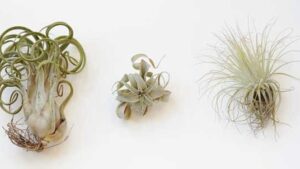How to Keep Your Air Plant Alive

When it comes to indoor plant care, air plants are supposed to be some of the easiest. For starters, they don’t even need soil, absorbing water and nutrients through scales on their leaves—in the wild they survive just hanging onto the bark of trees and whatnot, catching whatever bit of rain and bird poop that comes their way. But just like succulents and orchids, some people have trouble keeping them alive. I know because y’all tell me. I also know because I see a lot of parched, browning air plants that are clearly dying of thirst. I also see far too many holed up in closed terrariums—not a match for the circulation-loving plants. So learn how to keep your air plant alive.
1. Dunking is Best

I know you thought you’d be fine just spritzing your tilly every few days, but that isn’t enough. Air plants need just slightly more care than that. I’m known as the air plant whisperer around these parts, and this is what I do: Once a week, I dunk them in a container large enough to fully submerge them and let them sit there. For hours. I always intend to follow the advice to soak them overnight. But sometimes it’s Friday (I keep mine at work and don’t see them on the weekends), so I do it for a few hours. It varies, but a several-hour dunking once a week has killed none, and they’re all thriving.
2. Always Air Dry

After they soak, Tillandsias need to dry out fully. Fully! Shake off any excess water and put them in a bright spot for at least 4 hours. This is key, as dampness is the main foe of an air plant. Their poor little cores will rot if they don’t get to drain and dry out!
3. Filtered or Indirect Light
Bright filtered or indirect light is ideal for indoor air plants. Some direct sun works, too (morning is better), but they shouldn’t be baking all day. Think “rainforest” and do your best to reproduce those conditions in a small space.
4. Plants Get Hungry

For lush-looking plants that earn you bragging rights (such as being known as the “air plant whisperer, for example), feed your plants once a month by adding fertilizer to the water mix. Use abromeliad mix (air plants are in the bromeliad family), and don’t overdo it—plants can burn from too much fertilizer.
5. Nice and Cozy

The good news here is that you have to work pretty hard to mess this one up. Air plants are happy with a wide range of temps, from the 50s to the 90s. Just know that the hotter and drier the air, the more often you’ll have to water. And it probably comes as no surprise—these tenderhearted tropical and subtropical babies will bite the dust in freezing temps.
6. Open Up

I know, I know—glass terrariums are adorable, but air plants need circulation of, you know, air. An enclosed vessel encourages wet, stagnant conditions, and this spells disaster. If you just can’t get over glass, choose a vessel with as wide a hole as possible (like a fish bowl), and be sure to let plants dry fully before you place them back inside.
Website: www.sunset.com